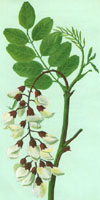View crop
View crop Data sheet EcoPortRobinia pseudoacacia
 |
|
| Notes |
|---|
| BRIEF DESCRIPTION A medium-sized, spiny, deciduous tree reaching a height of 15-30 m. The trunk is forking, slightly angled, often crooked with a diameter of up to 60 cm. The tree is shallow rooted and has a open irregular crown. The flower clusters are 10-20 cm long with many white, fragrant flowers. USES Wood used for fenceposts, mine timbers, flooring, furniture, vehicles, woodenware, railway crossties, boxes crates, skates, and firewood and charcoal. The tree is planted for shade, shelterbelts, wildlife cover, erosion control and as an ornamental. It is a source of honey. Leaves are used as fodder but may be toxic in quantity. Mentioned as a possible agroforestry species. GROWING PERIOD Fast-growing, short-lived perennial tree. The growth is rapid the first 15-30 years and ceases almost entirely after 50 years. Withstands dry periods of 2-6 months. COMMON NAMES False acacia, Black locust, Robinie, Robinia, Locust tree, Yellow locust. FURTHER INF In the Himalayan, False acacia is found at elevations from 1200 to 3300 m, and in Europe, from sea level to 2500 m. The species is indigenous to the Appalachian and Ozark mountains of the southeast and central parts of the United States. The latitudinal range of natural occurrence is 34-40°N. It is often found as a pioneer on old fields, burned areas, and lands strip-mined for coal. The tree is able to withstand air pollution and salt winds, but it suffers from wind damage, ice and snow break, and it is intolerant of shade. It is drought hardy, it fixes nitrogen and it can regenerate rapidly. Annual wood production potential is 4-20 m3/ha. It has been reported that humans, horses, cattle, sheep, and poultry may be poisoned by eating leaves, roots, bark, sprouts, seed pods, and trimmings. | Sources |
| Grassland Index Little E 1983 pp 250-253 [USE, LIMIT, KTMK, RAIN, TEXT, PH] Webb D 1984 pp 237 [RAIN, TEMP, TEXT, PH, DRA, SAL, LIG, USE] Sims D (pers. comm.) Troup R 1921 pp 332 National RC 1983c pp 42-45 [USE, TEMP, KTMP, LIG, RAIN, TEXT, PH, DRA, LIMITS] Janick J 1991 pp 432 INSPIRE species 154 [RAIN, TEMP, TEXT, PH, DRA, SAL, LIG, USE] Hensleight T 1988 pp 384 [TEMP, RAIN, TEXT, USE] |